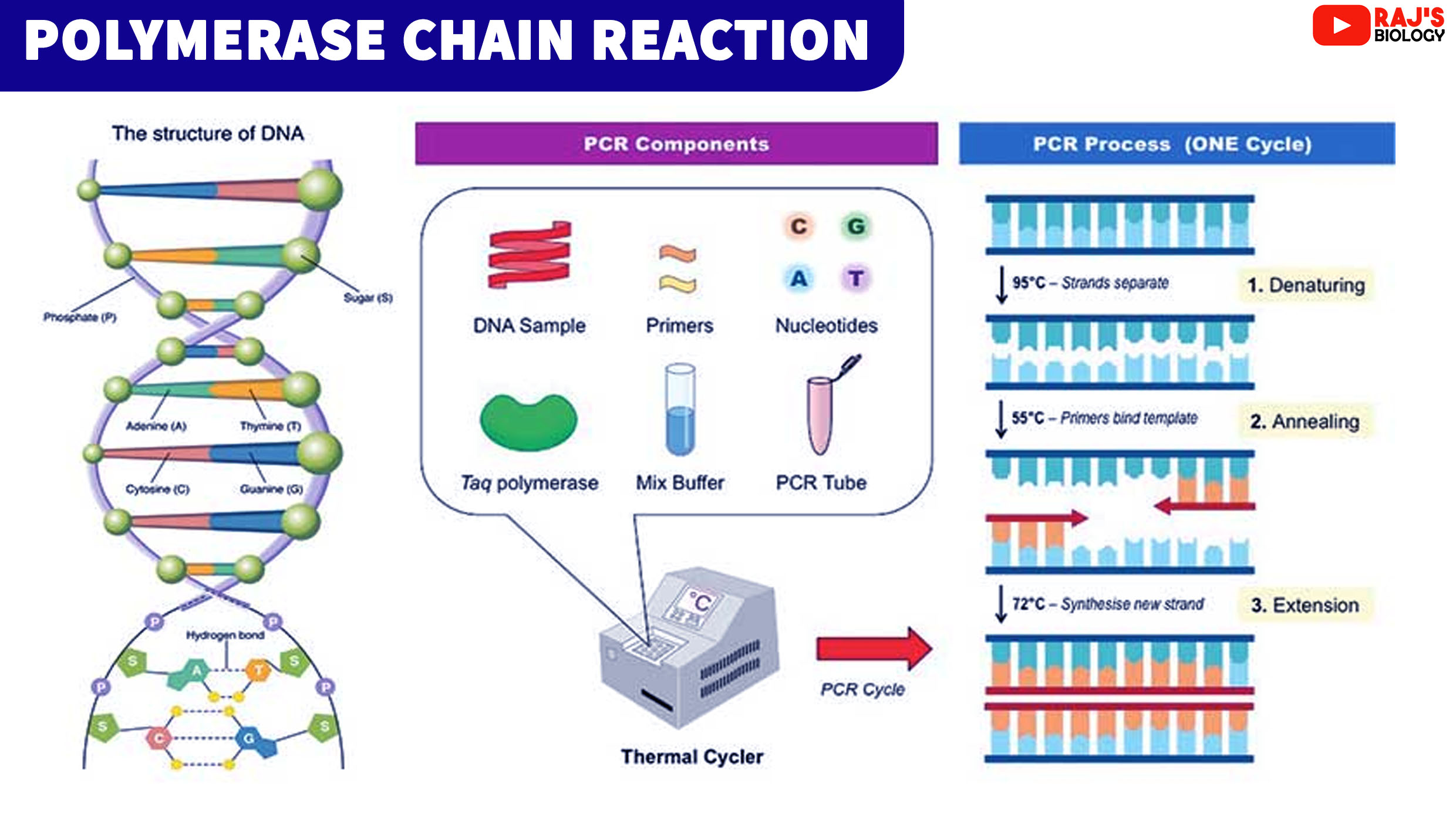In this article we will discuss about Principle of PCR, Requirements for PCR, Steps in Polymerase Chain Reaction and Applications of PCR
- PCR is an enzymatic process in which a specific region of DNA is replicated over and over again to yield many copies of a particular sequence.
- The most widely used target nucleic acid amplification method is the polymerase chain reaction (PCR).
- This method combines the principles of complementary nucleic acid hybridization with those of nucleic acid replication applied repeatedly through numerous cycles.
- This method is able to amplify a single copy of a nucleic acid target, often undetectable by standard hybridization methods, and multiply to 107 or more copies in a relatively short period.
- This thus provides ample target that can be readily detected by numerous methods.
Table of Contents
Principle of PCR
The principle of PCR is based on the enzymatic replication of nucleic acids. PCR involves the use of primer mediated enzymes for the amplification of DNA. DNA Polymerase synthesises new strands of DNA complementary to the template DNA. The DNA polymerase can add a nucleotide to the pre-existing 3’-OH group only. Therefore, a primer is required. Thus, more nucleotides are added to the 3’ prime end of the DNA polymerase.
Components Of PCR
Components Of PCR constitutes the following:
- DNA Template – The DNA of interest from the sample.
- DNA Polymerase – Taq Polymerase is used. It is thermostable and does not denature at very high temperatures.
- Oligonucleotide Primers – These are the short stretches of single-stranded DNA complementary to the 3’ ends of sense and anti-sense strands.
- Deoxyribonucleotide triphosphate – These provide energy for polymerization and are the building blocks for the synthesis of DNA. These are single units of bases.
- Buffer System – Magnesium and Potassium provide optimum conditions for DNA denaturation and renaturation. It is also important for fidelity, polymerase activity, and stability.
Steps in Polymerase Chain Reaction
Step #1 Denaturation
The reaction mixture is heated to 95°C for a short time period (about 15–30 sec) to denature the target DNA into single strands that can act as templates for DNA synthesis.
Step #2 Annealing
The mixture is rapidly cooled to a defined temperature which allows the two primers to bind to the sequences on each of the two strands flanking the target DNA. Primers are short, single-stranded sequences of nucleic acid (i.e., oligonucleotides usually 20 to 30 nucleotides long) selected to specifically hybridize (anneal) to a particular nucleic acid target, essentially functioning like probes. This annealing temperature is calculated carefully to ensure that the primers bind only to the desired DNA sequences (usually around 55oC). One primer binds to each strand. The two parental strands do not re-anneal with each other because the primers are in large excess over parental DNA.
Step #3 Elongation
The temperature of the mixture is raised to 72°C (usually) and kept at this temperature for a pre-set period of time to allow DNA polymerase to elongate each primer by copying the single-stranded templates. Annealing of primers to target sequences provides the necessary template format that allows the DNA polymerase to add nucleotides to the 3’ terminus (end) of each primer and extend sequence complementary to the target template
Taq polymerase is the enzyme commonly used for primer extension, which occurs at 72°C. This enzyme is used because of its ability to function efficiently at elevated temperatures and to withstand the denaturing temperature of 94°C through several cycles. The ability to allow primer annealing and extension to occur at elevated temperatures without detriment to the polymerase increases the stringency of the reaction, thus decreasing the chance for amplification of non-target nucleic acid (i.e., nonspecific amplification).
The three steps of the PCR cycle are repeated
- Thus in the second cycle, the four strands denature, bind primers and are extended. No other reactants need to be added. The three steps are repeated for a third cycle and so on for a set of additional cycles.
- By the third cycle, some of the PCR products represent DNA sequence only between the two primer sites and the sequence does not extend beyond these sites.
- As more and more reaction cycles are carried out, the double-stranded DNA are synthesized more in number. After 20 cycles, the original DNA has been amplified a million-fold and this rises to a billion fold (1000) million after 30 cycles.
Applications of PCR
PCR already has very widespread applications, and new uses are being devised on a regular basis.
- PCR can amplify a single DNA molecule from a complex mixture, largely avoiding the need to use DNA cloning to prepare that molecule. Variants of the technique can similarly amplify a specific single RNA molecule from a complex mixture.
- DNA sequencing has been greatly simplified using PCR, and this application is now common.
- By using suitable primers, it is possible to use PCR to create point mutations, deletions and insertions of target DNA which greatly facilitates the analysis of gene expression and function.
- PCR is exquisitely sensitive and can amplify vanishingly small amounts of DNA. Thus, using appropriate primers, very small amounts of specified bacteria and viruses can be detected in tissues, making PCR invaluable for medical diagnosis.
- PCR is now invaluable for characterizing medically important DNA samples. For example, in screening for human genetic diseases, it is rapidly replacing the use of RFLPs.
- Because of its extreme sensitivity, PCR is now fundamentally important to forensic medicine. It is even possible to use PCR to amplify the DNA from a single human hair or a microscopic drop of blood left at the scene of a crime to allow detailed characterization
